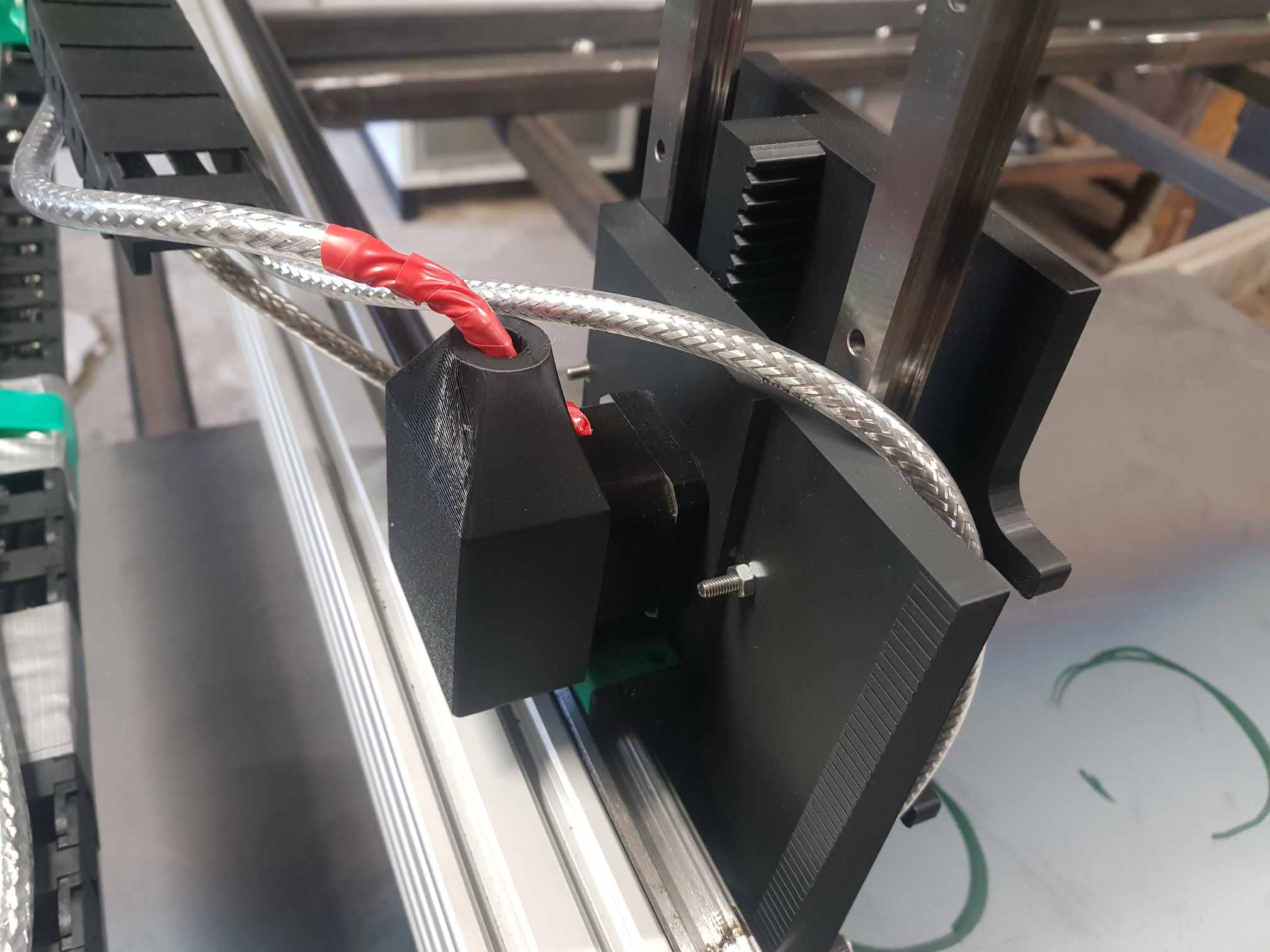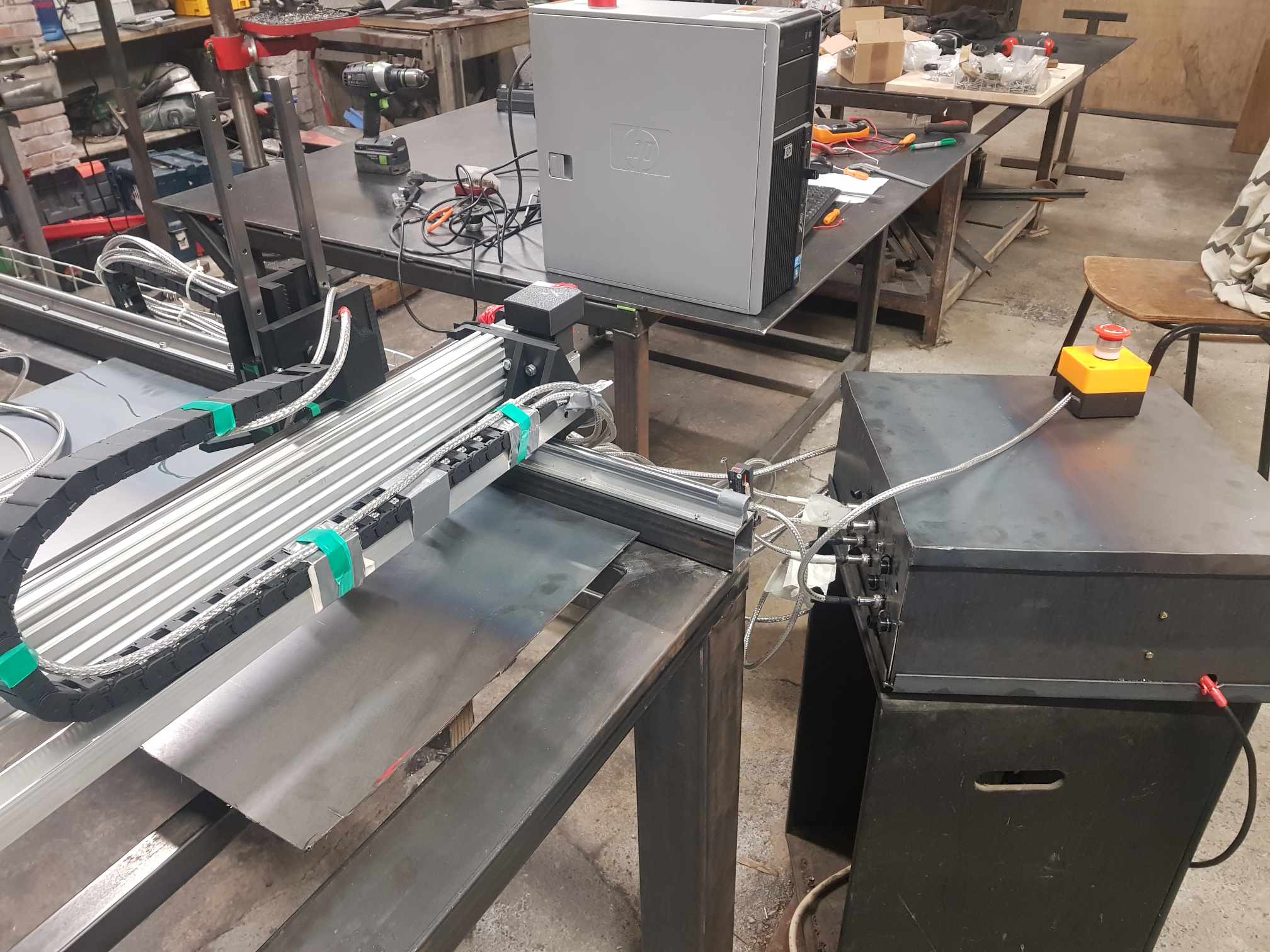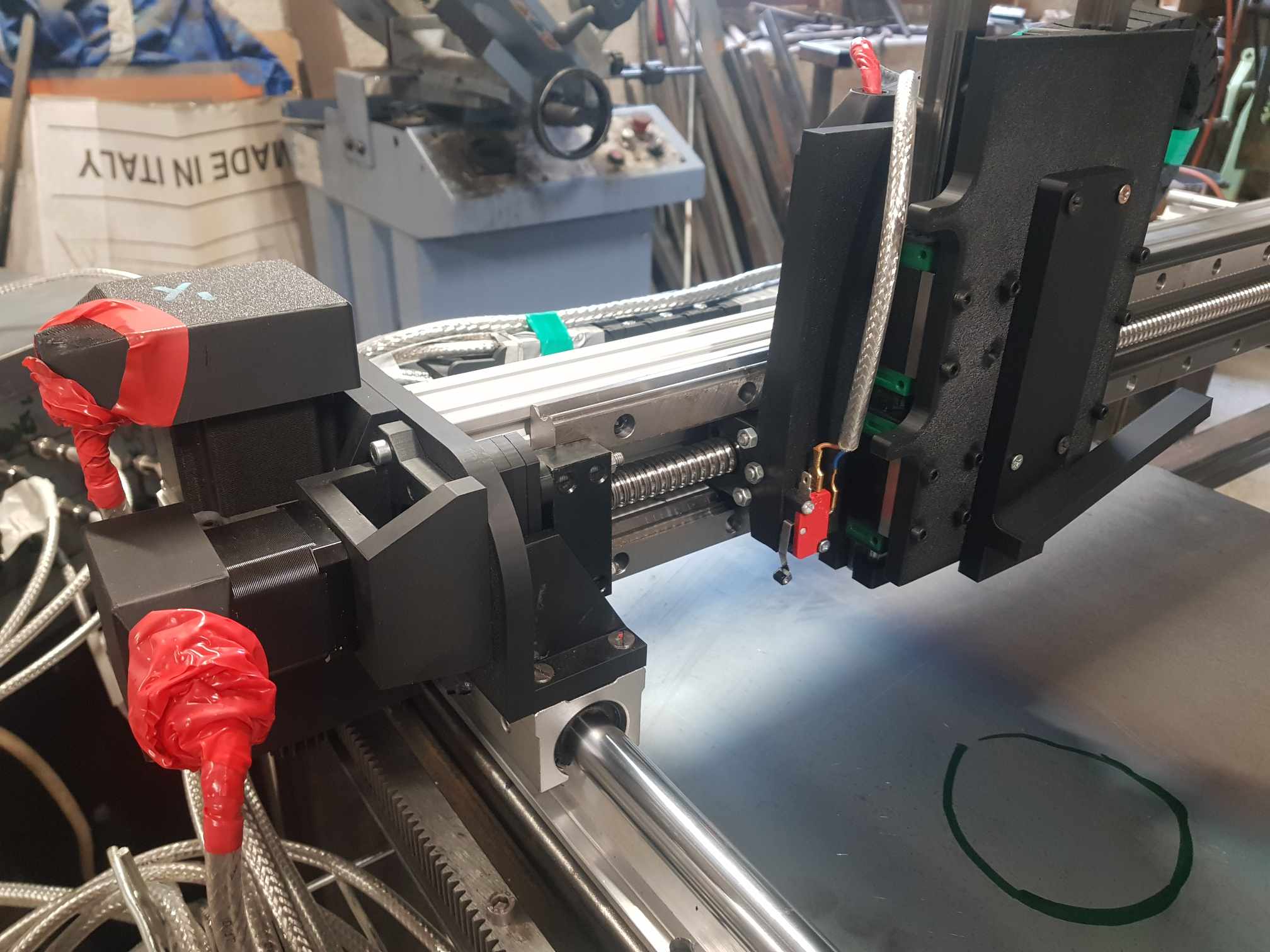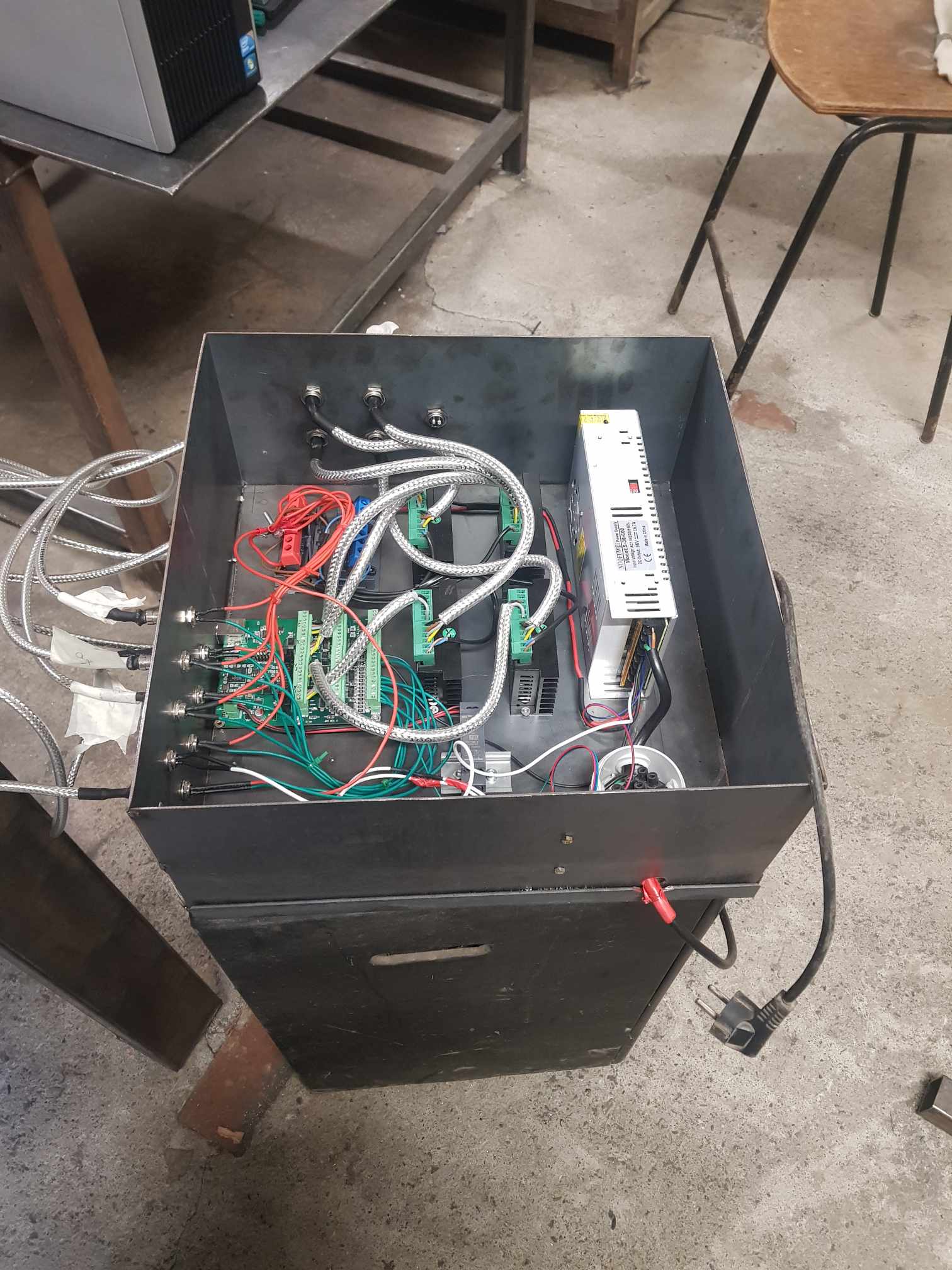The blacksmith's plasma table
- tommylight
-

- Away
- Moderator
-

Less
More
- Posts: 20983
- Thank you received: 7154
06 May 2024 12:36 #299935
by tommylight

Capacitors have no power rating, just capacity and voltage, sometimes temperature range in a form of a single letter. Anything from 300-500V will do just fine.
Replied by tommylight on topic The blacksmith's plasma table
Exactly !Also when you say you plugged the cheap china plasma through 2 resistors (both 1MO 2W) with a capacitor (0.1uF and what power rating ?) shorting the two, would it look like that :
Capacitors have no power rating, just capacity and voltage, sometimes temperature range in a form of a single letter. Anything from 300-500V will do just fine.
Please Log in or Create an account to join the conversation.
- polskleforgeron
- Offline
- Junior Member
-

Less
More
- Posts: 31
- Thank you received: 5
06 May 2024 14:07 #299943
by polskleforgeron
Also dumb question, I can easily fin some 300V AC 0.1uF capacitors. But we're talking DC here right ? Is it still OK or should I find a specific DC one ? I remember something about electrolytic capacitors that can only be use in DC..
Some pictures of the project !
Replied by polskleforgeron on topic The blacksmith's plasma table
Is it better to add the resistors and capacitors closer to the THCAD-2 or the connexion in the plasma cutter ? I feel like it would be better at the source, inside the frame of the plasma.
Also when you say you plugged the cheap china plasma through 2 resistors (both 1MO 2W) with a capacitor (0.1uF and what power rating ?) shorting the two, would it look like that :
Exactly !
Capacitors have no power rating, just capacity and voltage, sometimes temperature range in a form of a single letter. Anything from 300-500V will do just fine.
Also dumb question, I can easily fin some 300V AC 0.1uF capacitors. But we're talking DC here right ? Is it still OK or should I find a specific DC one ? I remember something about electrolytic capacitors that can only be use in DC..
Some pictures of the project !
Attachments:
Please Log in or Create an account to join the conversation.
- polskleforgeron
- Offline
- Junior Member
-

Less
More
- Posts: 31
- Thank you received: 5
06 May 2024 14:59 #299949
by polskleforgeron
Replied by polskleforgeron on topic The blacksmith's plasma table
Would this capacitor do the job ?
composant-electronique.fr/condensateur-1uf-400v-ccap1uf400v-b
I've read polypropylen ones are more stable in HF environment.
composant-electronique.fr/condensateur-1uf-400v-ccap1uf400v-b
I've read polypropylen ones are more stable in HF environment.
Please Log in or Create an account to join the conversation.
- tommylight
-

- Away
- Moderator
-

Less
More
- Posts: 20983
- Thank you received: 7154
06 May 2024 16:59 #299958
by tommylight
Replied by tommylight on topic The blacksmith's plasma table
Nope, that is 1uF, you need 0.1uF or 100nF
It does not mater much where, but i would still place the capacitor at the THCAD input, resistors inside the plasma.
Not a DC capacitor nor electrolytic one, metal film have no polarity and are good ad reducing interference.
It does not mater much where, but i would still place the capacitor at the THCAD input, resistors inside the plasma.
Not a DC capacitor nor electrolytic one, metal film have no polarity and are good ad reducing interference.
The following user(s) said Thank You: polskleforgeron
Please Log in or Create an account to join the conversation.
- polskleforgeron
- Offline
- Junior Member
-

Less
More
- Posts: 31
- Thank you received: 5
07 May 2024 10:00 #300024
by polskleforgeron
While I greatly appreciate all your advice, it bother me to not understand why I'm adding a capacitor. Would you have some ressources where I can learn what this capacitor does in this case ? I tried to look it up but I dont even know where to start, there is so much information.
Does the capacitor act as some kind of "electronic spring" to absorb a HV surge ? And how did you know which capacity and voltage it should have ?
Replied by polskleforgeron on topic The blacksmith's plasma table
Nope, that is 1uF, you need 0.1uF or 100nF
It does not mater much where, but i would still place the capacitor at the THCAD input, resistors inside the plasma.
Not a DC capacitor nor electrolytic one, metal film have no polarity and are good ad reducing interference.
While I greatly appreciate all your advice, it bother me to not understand why I'm adding a capacitor. Would you have some ressources where I can learn what this capacitor does in this case ? I tried to look it up but I dont even know where to start, there is so much information.
Does the capacitor act as some kind of "electronic spring" to absorb a HV surge ? And how did you know which capacity and voltage it should have ?
Please Log in or Create an account to join the conversation.
- tommylight
-

- Away
- Moderator
-

Less
More
- Posts: 20983
- Thank you received: 7154
07 May 2024 13:45 #300034
by tommylight
Replied by tommylight on topic The blacksmith's plasma table
In this case, it acts as a dead short for the AC interference while the HV start/pilot is on, it does not affect the DC voltage that THCAD needs to measure.
Please Log in or Create an account to join the conversation.
- polskleforgeron
- Offline
- Junior Member
-

Less
More
- Posts: 31
- Thank you received: 5
13 May 2024 11:18 - 13 May 2024 11:20 #300503
by polskleforgeron
Does it ?
Replied by polskleforgeron on topic The blacksmith's plasma table
I found this paper which seems to explaina little bit the subject : www.vishay.com/docs/28153/acfilmconnectionmains.pdfIn this case, it acts as a dead short for the AC interference while the HV start/pilot is on, it does not affect the DC voltage that THCAD needs to measure.
Does it ?
Last edit: 13 May 2024 11:20 by polskleforgeron.
The following user(s) said Thank You: tommylight
Please Log in or Create an account to join the conversation.
- tommylight
-

- Away
- Moderator
-

Less
More
- Posts: 20983
- Thank you received: 7154
13 May 2024 11:28 #300505
by tommylight
Replied by tommylight on topic The blacksmith's plasma table
Yes it does, on the first page.
Capacitors are funny, for some frequencies they act as a short while for some other frequencies they act as they do not exist!
China uses them to lower the mains voltage on all cheap adapters/LED lights/chargers/toys/etc, as they can lower the voltage without the need to dissipate huge amounts of power. That also makes these devices extremely dangerous as there is no isolation from the mains.
To much stuff they do to be able to put it inside a single reply.
Capacitors are funny, for some frequencies they act as a short while for some other frequencies they act as they do not exist!
China uses them to lower the mains voltage on all cheap adapters/LED lights/chargers/toys/etc, as they can lower the voltage without the need to dissipate huge amounts of power. That also makes these devices extremely dangerous as there is no isolation from the mains.
To much stuff they do to be able to put it inside a single reply.
The following user(s) said Thank You: polskleforgeron
Please Log in or Create an account to join the conversation.
- polskleforgeron
- Offline
- Junior Member
-

Less
More
- Posts: 31
- Thank you received: 5
16 May 2024 14:40 - 16 May 2024 14:45 #300753
by polskleforgeron
Replied by polskleforgeron on topic The blacksmith's plasma table
Hi Tommy,
I've received everything I needed to finish the build, 0.1uf capacitors, 1M 2W resistors and wired everything. My base machine was working fine, following 2D gcode comand etc.
I started to follow the step in the plasmac configuration page and got an error message on the first one --'
When I try to run the command :
python /usr/share/doc/linuxcnc/examples/sample-configs/by_machine/plasmac/configurator.py
It tells me no such file exist. I dont have a "plasmac" repertory at this path. I've tried to find elsewhere "configurator.py" or a "plasmac" repertory with no luck.
I thought maybe my linuxcnc installation was incomplete so I tried with the debian iso found on the linuxcnc installation guide but there was no plasmac repertory at this path either.
I have no idea what I'm doing wrong. The second time I litteraly followed the step on the "getting linuxcnc" page. Do you have any idea ?
I've received everything I needed to finish the build, 0.1uf capacitors, 1M 2W resistors and wired everything. My base machine was working fine, following 2D gcode comand etc.
I started to follow the step in the plasmac configuration page and got an error message on the first one --'
When I try to run the command :
python /usr/share/doc/linuxcnc/examples/sample-configs/by_machine/plasmac/configurator.py
It tells me no such file exist. I dont have a "plasmac" repertory at this path. I've tried to find elsewhere "configurator.py" or a "plasmac" repertory with no luck.
I thought maybe my linuxcnc installation was incomplete so I tried with the debian iso found on the linuxcnc installation guide but there was no plasmac repertory at this path either.
I have no idea what I'm doing wrong. The second time I litteraly followed the step on the "getting linuxcnc" page. Do you have any idea ?
Last edit: 16 May 2024 14:45 by polskleforgeron.
Please Log in or Create an account to join the conversation.
- tommylight
-

- Away
- Moderator
-

Less
More
- Posts: 20983
- Thank you received: 7154
16 May 2024 17:09 #300768
by tommylight
Replied by tommylight on topic The blacksmith's plasma table
2.9 and Master/2.10 have QtPlasmaC, so the PncConf wizard can create a full configuration for plasma, thanks to CMorley and PhillC.
It should be on the menu, cnc, PncConf.
It should be on the menu, cnc, PncConf.
Please Log in or Create an account to join the conversation.
Moderators: snowgoer540
Time to create page: 0.194 seconds






